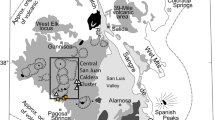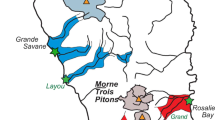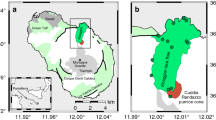Abstract
The Pollara tuff-ring resulted from two explosive eruptions whose deposits are separated by a paleosol 13 Ka old. The oldest deposits (LPP, about 0.2 km3) consist of three main fall units (A, B, C) deposited from a subplinian column whose height (7–14 km) increased with time from A to C, as a consequence of the increased magma discharge rate during the eruption (1–8x106 kg/s). A highly variable juvenile population characterizes the eruption. Black, dense, highly porphyritic, mafic ejecta (SiO2=50–55%) almost exclusively form A deposits, whereas grey, mildly vesiculated, mildly porphyritic pumice (SiO2=56–67%) and white, highly vesiculated, nearly aphyric pumice (SiO2=66–71%) predominate in B and C respectively. Mafic cumulates are abundant in A, while crystalline lithic ejecta first appear in B and increase upward. The LPP result from the emptying of an unusual and unstable, compositionally zoned, shallow magma chamber in which high density mafic melts capped low density salic ones. Evidence of the existence of a short crystal fractionation series is found in the mafic rocks; the andesitic pumice results from complete blending between rhyolitic and variously fractionated mafic melts (salic component up to 60 wt%), whereas bulk dacitic compositions mainly result from the presence of mafic xenocrysts within rhyolitic glasses. Viscosity and composition-mixing diagrams show that blended liquids formed when the visosities of the two end members had close values. The following model is suggested: 1. A rhyolitic magma rising through the metamorphic basement enterrd a mafic magma chamber whose souter portions were occupied by a highly viscous, mafic crystal mush. 2. Under the pressure of the rhyolitic body the nearly rigid mush was pushed upwards and mafic melts were squeezed against the walls of the chamber, beginning roof fracturing and mingling with silicic melts. 3. When the equilibrium temperature was reached between mafic and silicic melts, blended liquids rapidly formed. 4. When fractures reached the surface, the eruption began by the ejection of the mafic melts and crystal mush (A), followed by the emission of variously mingled and blended magmas (B) and ended by the ejection of nearly unmixed rhyolitic magma (C).
Similar content being viewed by others
References
Barberi F, Gandino A, Gioncada A, La Torre P, Sbrana A, Zenucchini C (1993) The deep structure of the Eolian Arc (Filicudi-Panarea-Vulcano sector) in light of gravity, magnetic and volcanological data. J Volcanol Geotherm Res, in press
Blake S (1984) Magma mixing and hybridization processes at the alkalic, silicic Torfajokull central volcano triggered by tholeiitic Veidivotn fissuring, South Iceland. J Volcanol Geotherm Res 22:1–31
Blake S, Ivey GN (1986) Magma mixing and the dynamics of withdrawal from stratified reservoirs. J Volcanol Geotherm Res 27:153–178
Calanchi N, De Rosa R, Mazzuoli R, Ricci Lucchi F, Rossi PL, Santacroce R (1988) L'attivita' del centro di Pollara (Salina, Isole Eolie) Boll GNV, Pisa 1987:187–213
Campbell IH, Turner JS (1986) The influence of viscosity on fountains in magma chambers. J Petrol 27:1–30
Carey S, Sparks RSJ (1986) Quantitative models of the fallout and dispersal of tephra from volcanic eruption columns. Bull Volcanol 48:109–125
Civetta L, Galati R, Santacroce R (1991) Magma mixing and convective compositional layering within the Vesuvius magma chamber. Bull Volcanol 53:287–300
De Rosa R, Mazzuoli R, Rossi PL, Santacroce R, Ventura G (1990) Nuovi dati per la ricostruzione della storia eruttiva dell' isola di Salina (Isole Eolie). Boll GNB, Pisa 1989, 2:809–825
Ferriz H, Mahood GA (1987) Strong compositional zonation in a silicic magmatic system: Los Humeros, Mexican Neovolcanic Belt. J Petrol 28:171–209
Ford CE, Russel DG, Craven JA, Fisk MR (1983) Olivine-liquid equilibria: temperature, pressure and composition dependence of the crystal/liquid cation partition coefficients for Mg, Fe2+, Ca and Mn. J Petrol 24.3:256–265
Furman T, Spera FJ (1985) Commingling of acid and basic magma with implications for the origin of I-type xenoliths: field and petrological relations of an unusual dike complex at Eagle Lake, Sequoia National Park, California, USA. J Volcanol Geotherm Res 24:151–178
Gill JB (1981) Andesites and plate tectonics. Springer Verlag, Berlin, New York, 1–300
Gillot PY (1987) Histoire volcanique des Iles Eoliennes: arc insulaire ou complexe orogenique anulaire? DT IGAL 11:35–42
Gillot PY, Villari L (1980) K-Ar geochronological data on the Aeolian Volcanism. A preliminary report. Open File 3/80 I.I.V., Catania: 8 pp
Huppert HE, Sparks RSJ, Turner JS (1982) Effect of volatiles on mixing in calc-alkaline magma systems. Nature 297:554–557
Huppert HE, Sparks RSJ, Turner JS (1984) Some effects of viscosity on the dynamics of replenished magma chambers. J Geophys Res 89:6857–6877
Huppert HE, Sparks RSJ, Whitehead JA, Hallworth MA (1986) The replenishment of magma chambers by light inputs. J Geophys Res 91:6113–6122
Keller J (1980) The island of Salina. Rend Soc It Miner Petrol 36:489–524
Kouchi A, Sunagawa I (1985) A model for mixing basaltic and dacitic magmas as deduced from experimental data. Contrib Mineral Petrol 89:17–23
Leake BE (1978) Nomenclature of amphiboles. Am Mineral 63:1023–1052
Leeman WP, Scheidegger KF (1977) Olivine-liquid distribution coefficient and a test for crystal-liquid equilibrium. Earth Planet Sci Lett 35:247–257
McBirney AR, Noyes RM (1979) Crystallization and layering of the Skaergard intrusion. J Petrol 20:487–514
McBirney AR, Murase TM (1984) Rheological properties of magmas. Ann Rev Earth Planet Sci 12:337–357
Peccerillo A, Taylor SR (1976) Geochemistry of Eocene calcalkaline volcanic rocks from the Kastamanu area, northern Turkey, Bull Volcanol 39:557–569
Pyle DM (1989) The thickness, volume and grainsize of tephra fall deposits. Bull Volcanol 51:1–15
Santacroce R (1983) A general model of the behaviour of the Somma Vesuvius volcanic complex. J Volcanol Geotherm Res 17:237–248
Shaw HR (1972) Viscosities of magmatic liquids: an empirical method of prediction. Am J Sci 272:870–893
Sigurdsson H, Cornell W, Carey S (1990) Influence of magma withdrawal oncompositional gradients during the A.D. 79 Vesuvius eruption. Nature 345:519–521
Sparks RSJ (1986) The dimensions and dynamics of volcanic eruption columns. Bull Volcanol 48:3–15
Sparks RSJ, Sigurdsson H, Wilson L (1977) Magma mixing: a mechanism for triggering acid explosive eruptions. Nature 267:315–318
Sparks RSJ, Marshall LA (1986) Thermal and mechanical constraints on mixing between mafic and silicic magmas. J Volcanol Geotherm Res 29:99–124
Spera FJ (1984) Some numerical experiments on the withdrawal of magma from crustal reservoirs. J Geophys Res 89:8222–8236
Spera FJ, Yuen DA, Greer JC, Sewell G (1986) Dynamics of magma withdrawal from stratified magma chambers. Geology 14:723–726
Stormer JC, Nicholls J (1978) XLFRAC: a program for the iterative testing of magmatic differentiation models. Computer Geosci 4:143–159
Tait SR, Huppert HE, Sparks RSJ (1984) The role of compositional convection in the formation of adcumulate rocks. Lithos 17:139–146
Thompson RN (1980) Askja 1875, Skye 56 Ma: basalt-triggered plinian, mixed-magma eruptions during the emplacement of the Western Red Hills Granite, Isle of Skye, Scotland. Geol Rundsch 69:245–262
Turner JS, Huppert HE, Sparks RSJ (1983) An experimental investigation of volatile exsolution in evolving magma chambers. J Volcanol Geotherm Res 16:263–277
Wager LR (1961) Types of igneous cumulates. J Petrol 1:73–85
Author information
Authors and Affiliations
Rights and permissions
About this article
Cite this article
Calanchi, N., De Rosa, R., Mazzuoli, R. et al. Silicic magma entering a basaltic magma chamber: eruptive dynamics and magma mixing — an example from Salina (Aeolian islands, Southern Tyrrhenian Sea). Bull Volcanol 55, 504–522 (1993). https://doi.org/10.1007/BF00304593
Received:
Accepted:
Issue Date:
DOI: https://doi.org/10.1007/BF00304593




